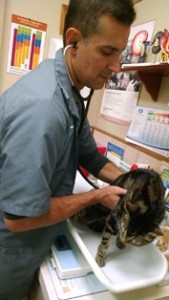
Feline Lower Urinary Tract Disease
Have you noticed your cat urinating more frequently or appearing to strain during urination? What about blood in the urine, or frequent licking of his/her hind quarters? Your kitty may be suffering from Feline Lower Urinary Tract Disease (FLUTD) which is actually a collection of clinical symptoms that may have more than one possible cause.
Problems that affect a cat’s lower urinary system often prevent the bladder from emptying correctly or may even cause fatal blockage of the urethra, the tube connecting the bladder to the outside of the body.
FLUTD is rarely diagnosed in animals younger than one year; the average age is typically four years. Male cats are generally more prone to urethral blockages because of their narrower urethras.
Symptoms require immediate veterinary care! Please contact your veterinarian right away if you notice any of the following symptoms in your cat:
- Inability to urinate or only passing a small amount of urine
- Bloody or cloudy urine
- Loss of bladder control, dribbling urine
- Increased frequency of urination or visits to the litter box
- Straining and/or crying out in pain when trying to pass urine
- Prolonged squatting in litter box
- Fear/avoidance of litter box and soiling in inappropriate places
- Constant licking of urinary opening
- Strong odor of ammonia in urine
- Lethargy
- Vomiting
- Increased water consumption
- Hard, distended abdomen
It’s important to arrange an exam with your veterinarian as soon as symptoms are noticed, especially if your cat is straining to urinate and crying indicating pain. A partial or complete obstruction of the urethra may have occurred that can very quickly lead to kidney failure and/or rupture of the bladder. An obstruction can prove fatal if the obstruction is not relieved right away and the cause determined and treated.
A complete physical exam will be in order which may include a urinalysis, urine culture, blood work, radiographs or ultrasound.
Some of the causes may be due to the following:
- Stones, crystals or debris accumulation in the bladder or urethra
- Urethral plug (accumulation of debris from urine)
- Bladder inflammation or infection
- Incontinence from excessive water drinking or weak bladder
- Injury to, or tumor in, the urinary tract
- Stress
- Spinal cord problems
- Congenital abnormality
- Endocrine diseases (hyperthyroidism, diabetes mellitus)
Depending on your cat’s prognosis, treatment may include:
- Antibiotics or other medications
- Dietary changes
- Increase in water intake
- Urinary acidifiers
- Expelling of small stones through urethra
- Surgery to either remove bladder stones or tumor, or to correct congenital abnormality
- Urinary catheter or surgery to remove urethral blockage in male cats
- Fluid therapy
It’s very important to follow your veterinarian’s instructions once a diagnosis is made. Because FLUTD can have serious fatal consequences if left untreated, close monitoring of your cat at home with strict adherence to diet and medications recommended by your veterinarian is of the utmost importance. Follow up examinations may be recommended to ensure the cat is maintaining satisfactory urinary tract health.










